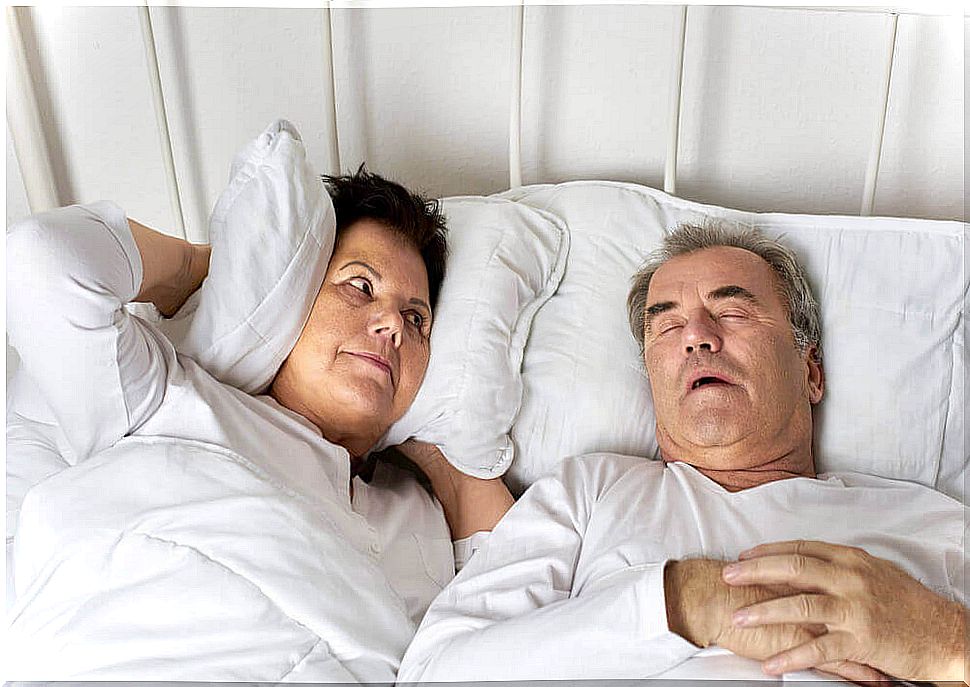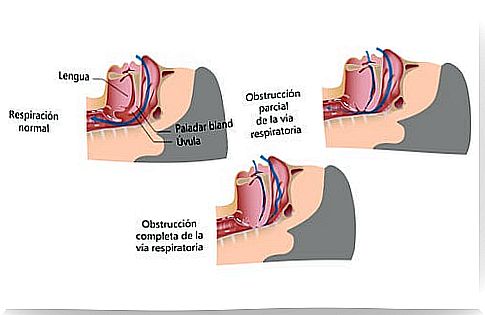Snoring: Causes And Treatment
Snoring is relatively often associated with a disease, particularly sleep apnea. In this article we review the physiology of snoring, possible causes, and treatments.

Snoring is not only an aesthetic or social inconvenience, but it could also be the symptom of a disease. There are many reasons why a person snores. Some of them respond to the suffering of certain pathologies.
However, snoring does not always mean that there is an associated disease. Sometimes it is due to the configuration of the airways. Others respond to the postures we adopt while we sleep or to unhealthy resting habits.
It is also known that snoring is more common among men and that women snore more during menopause. Some doctors believe that children should never snore. If they do, a study may need to be done.
What is snoring?

Snoring is a hoarse noise, originated in the vibration that occurs when taking the air in the nasooral structures. Obviously, it occurs in the inspiratory phase of breathing and results in the uncomfortable sound that we have all heard at some time.
The intensity of snoring depends on the amount of space available for air to pass through and the weakness of the organs around the nasooral structures. These are: pharynx, tongue, bell and palate.
In summary, snoring is a consequence that is produced by the flapping of the tissues of the throat, nose and, especially, the back of the palate. It is estimated that there is no snoring when the person is awake, because the tissues are more rigid during wakefulness.
Why is it produced?
A person who snores every day, for most of the time, may have one or more of the following characteristics :
- Overdevelopment of throat tissues . The tonsils are very large or the adenoids have developed excessively. This is common in obese people. There could also be cysts or tumors.
- Low-pitched throat or tongue muscles. It means that the muscles are very loose and this leads to the tongue falling backwards. This, along with the throat muscles, obstructs breathing.
- Soft palate and uvula of excessive length. The soft palate acts as a kind of flow valve. When it is very large and relaxed, it leaves little room for air to pass through. If the uvula is very large, the effect is similar or more severe.
- Obstructed nasal airways. When air is not sucked in normally through the nose, a vacuum is produced that pushes the soft tissues into the throat. This explains why a person with the flu snores, when he usually does not.
Other causes of snoring

Snoring is often a symptom of some type of sleep breathing disorder. This disorder can be mild or, on the contrary, be more serious. What differentiates them from each other is the degree of obstruction they cause in the airways.
The most serious of these disorders is Obstructive Sleep Apnea Syndrome (OSAS). Those who suffer from it suffer five or more episodes in which they stop breathing, or do so very slightly, within an hour.
Likewise, those who suffer from OSAS have daytime sleepiness, because they do not have a restful sleep. Likewise, it is common for them to wake up with a feeling of suffocation or suffocation. It is a delicate situation, which must be assessed by the doctor.
Treatment for snoring

The most common measures to treat snoring are the following :
- Oral devices: these are devices that advance the position of the jaw, tongue and palate to keep the airways open. Adaptation can be somewhat uncomfortable and can sometimes lead to jaw pain or dry mouth.
- Use of a pressurized mask: it is a method indicated for those who suffer from obstructive apnea. The mask is connected to a pump that forces air to pass through the airways. This keeps them open.
- Palate implant: consists of the placement of polyester threads on the soft palate, to harden it. There are not enough studies on the efficacy of this method yet.
- Conventional surgery: performed to trim and reduce excess tissue in the throat. It is, in general, a safe procedure. It can also be done with lasers, with some slight variations.
It is advisable for people who snore to lose weight, if they are obese. It is also important to sleep on your side and elevate the head. The consumption of alcohol, sedatives and tobacco should be avoided. If after having adopted this lifestyle the snoring does not disappear, it is advisable to consult an otolaryngologist.








